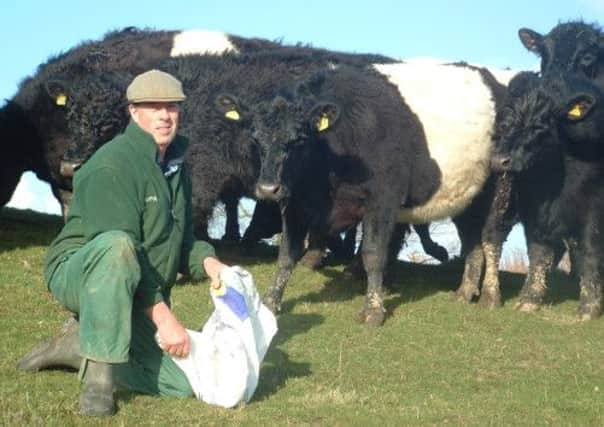Return of the native breeds pays off


Chris Ryder is living in a black and white world right now. He has mountains of paperwork to get through from his office at Scaife Hall Farm near Blubberhouses but it’s the keeping of a breed for the last four years that has set his life wholly in monochrome.
The farm runs to 600 acres and is tenanted from Yorkshire Water. Chris and his wife, also Chris, came here 26 years ago when they were married and have built up a highly reputable breeding ewe flock of 800 Swaledales. For the past 10 years they have sold most of them privately into Kent. They also have a breeding flock of Mules with fat lambs sold at Skipton Livestock Market.
Advertisement
Hide AdAdvertisement
Hide AdBut the sheep are no longer the only black and white livestock on the farm as the Ryders now have a pedigree herd of 40 Belted Galloways that they started with four years ago. It’s a move back towards native breeds that is all part of the Natural England philosophy and one that Chris is particularly encouraged by. So why is there a return to native breeds such as the Belties?
“Five years ago we entered the Higher Level Stewardship scheme at the same time as we had just taken on more land. It meant that half of the farm is now grassland and half is rough land.
“As part of our stewardship we were advised to introduce cattle because of the grasses on the rougher land and managing it properly to enhance wildlife.
“Years ago we had kept a Limousin suckler herd but we had gone out of cattle because we began retailing our lamb. We had gone into it when the price of lamb was £40 and retailing it ourselves to local pubs and hotels was a better way to go but when we took on more land something had to give.
Advertisement
Hide AdAdvertisement
Hide Ad“At the end of the day I’m a farmer not a butcher and although we enjoyed what we did and saw an insight into the butchery side I always prefer the idea of keeping stock.”
There are plenty of farmers who see government-run organisations as pencil pushers who know nothing of the real world of agriculture, but Chris has been pleasantly surprised by the way in which things have worked out so far at Scaife Hall.
“Natural England are quite good actually. If you work with them they will work with you. Where they want you to have the cattle is on the rough land and you can pretty much keep any breed you like, it’s just that you get a better payment if you keep native pedigree breeds.
“We felt that we needed a hardy breed for around here. We had a look at Shorthorns but felt they just weren’t hardy enough for us up on the hill, and we looked at Aberdeen Angus but as a lot of them now have Canadian blood we wouldn’t have received the higher payment.
Advertisement
Hide AdAdvertisement
Hide Ad“I didn’t want Longhorns or Highlands because their horns I find a nuisance. In the end we went with Belties because quite simply we like the look of them.
“They are such an easy breed to work with. They calve in May and June just after the lambs and we’ve never had to calve one yet.
“The hardest thing I have to do is to get two tags in the calf’s ear before it disappears into the wide blue yonder. We now have 40 of them and a bull, and we keep buying a few from local people and the main breed sales in Castle Douglas. We’re looking forward to attending the local annual breed sale at Thirsk next month and if we see something that is the right quality we may be tempted.”
Keeping traditional breeds is only one part of the Higher Level scheme that the Ryders have become involved with. They have also undertaken planting of woodland, dry stone walling and have sown 50 acres of traditional meadowland. Chris is very happy with what they have achieved and is aware of the efforts made on their behalf from elsewhere.
Advertisement
Hide AdAdvertisement
Hide Ad“We have sown wild flowers from old grasses collected from local sites in the Nidderdale Area of Outstanding Natural Beauty and we are grateful for all the help we havereceived from Marjorie Davy of Natural England and Marion Wilby of Nidderdale AONB in Pateley Bridge.”
The Ryders earned a conservation award at Nidderdale Show four years ago. The Annual Pedigree Belted Galloway Sale takes place at Thirsk Livestock Centre on Saturday, May 11.